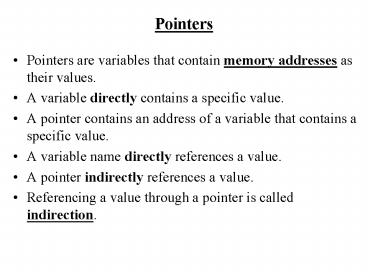Pointers - PowerPoint PPT Presentation
1 / 10
Title: Pointers
1
Pointers
- Pointers are variables that contain memory
addresses as their values. - A variable directly contains a specific value.
- A pointer contains an address of a variable that
contains a specific value. - A variable name directly references a value.
- A pointer indirectly references a value.
- Referencing a value through a pointer is called
indirection.
2
Directly and Indirectly referencing a variable
- sum
- sumPtr sum
sum directly references a variable whose value
is 5
5
sumPtr indirectly references a variable
whose value is 5
5
3
Initialization
- A pointer may be initialized to 0 , NULL or an
address. - NULL is a symbolic constant defined in ltstdio.hgt
- A pointer with the value NULL points to nothing.
- The only integer that can be assigned to a
pointer is 0. - Dereferencing
- The operator indirection or dereferencing
operator, returns the value of the object that
its operand points to in memory. This is called
dereferencing the pointer.
4
/ Program to display the address and value of a
pointer /
- include ltstdio.hgt
- int main()
- int a
- int aPtr
- a 200
- aPtr a
- printf(The address of a is p \n, a)
- printf(The value of aPtr is p \n, aPtr)
- printf(The value of a is d \n, a)
- printf(The value of aPtr is d \n,
aPtr)
5
Calling functions by reference
- include ltstdio.hgt
- void cubebyref( int )
- int main()
- int num 5
- printf(The number is d \n,num)
- cubeByRef(num)
- printf(The new value of number is d
\n,num) - return 0
- void cubeByRef(int numPtr)
- numPtr nPtr nPtr nPtr
6
Relationship between Pointers and Arrays
- An array name is the address of the first element
of an array. - int b5
- The address of the first element
- using p to print - b, b0, b.
- Assume that int b5 and pointer variable bPtr
have been declared. Since the array name is a
pointer to the first element of the array - bPtr b
- This is equivalent to bPtr b0
- Array element b1 can be referenced by
- ( bPtr 1)
- 1 is the offset to the pointer.
- The preceding notation is called pointer / offset
notation.
7
- In pointer/offset notation, the offset is the
same as the array subscript. - Pointers can be subscripted exactly as arrays
can. - bPtr1 refers to the array element b1.
- This is called pointer / subscript notation.
8
- include ltstdio.hgt
- int main()
- int b 10 , 20 , 30 , 40
- int bPtr b
- int i, offset
- printf(Pointer/offset notation where the
pointer is ) - printf(the array name \n)
- for(offset 0 offset lt 4 offset)
- printf((b d) d \n, offset, ( b
offset) ) - printf(Pointer/subscript notation \n)
- for( i 0 i lt 4 i)
- printf(bPtr d d \n, i, bPtr i )
- printf(pointer/offset notation \n)
9
- include ltstdio.hgt
- void copy( char , const char )
- int main()
- char string110, string2 CS230
- char string310, string4 Lab
- copy(string1, string2)
- printf(string1 s \n,string1)
- copy(string3,string4)
- printf(string3 s \n,string3)
- return 0
10
- void copy(char s1, const char s2)
- int i 0
- do
- s1i s2i
- i
- while (s2i ! \0)
- s1i \0































